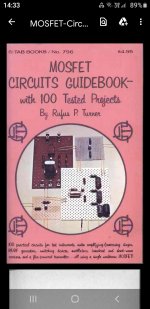Hello al guys. Anybody tryed dual gate MOSFETs as audio preamplifiers? Like 40xxx series of RCA, BFxxx fron Europe and 3SKxx from japanese manufacturers.
I refer best g2 bias, load resistance and voltage gain available. Supposedly to be low noise devices?
Many thanks in advance.
I refer best g2 bias, load resistance and voltage gain available. Supposedly to be low noise devices?
Many thanks in advance.
Do they make for a handy one-active-component modulator? Signal on G1, second signal on G2, output G1 * G2? If so, one could use to make a 2nd harmonic generator. Never seen that done, which makes me suspect it doesnt work that way...
In a radio, do they "mix" a local oscillator with the tuned input signal, for the IF? Surprised they're still available for a "new design"!
In a radio, do they "mix" a local oscillator with the tuned input signal, for the IF? Surprised they're still available for a "new design"!
Tryed long time ago as a front end of a simple line preamp. G1 and G2 wired together. Pretty noisy but still bearable. Sounded interesting but with obvious collorations.
Joining both gates doesn't convert it in a doubler, it behaves like a single gate unit.
In many aspects, they act as pentodes. But joining the gates like a triode.
I have several of them new and recovered. All them saved in a metal can to protect them from electric fields. (I am ham radio so sometimes large fields are around me when transmitting).
I found this book freely googling. Interesting projects.
In many aspects, they act as pentodes. But joining the gates like a triode.
I have several of them new and recovered. All them saved in a metal can to protect them from electric fields. (I am ham radio so sometimes large fields are around me when transmitting).
I found this book freely googling. Interesting projects.
Attachments
Last edited:
Well, a quick web search turns up all kinds of "Mixers", where a local oscillator is "mixed" with RF to produce a signal for an IF strip.
When I plug my guitar and microphone into my Behringer "mixer", the two inputs dont produce upper and lower sidebands off each others frequencies - AFAICT... Maybe my hearing is just bad 🙂
Here's one circuit where the gain is controlled by a second signal. Sounds like Amplitude Modulation to me.

When I plug my guitar and microphone into my Behringer "mixer", the two inputs dont produce upper and lower sidebands off each others frequencies - AFAICT... Maybe my hearing is just bad 🙂
Here's one circuit where the gain is controlled by a second signal. Sounds like Amplitude Modulation to me.
A.G.C. = Automatic Gain Control. Corrects slow changes of the signal strength.
Otherwise known as a "compressor" in audio, vs the RF realm. I've never seen one made with dual gate fets though. One would think if they had the bandwidth to handle 100's of Mhz, they'd also handle a few _K_Hz too.A.G.C. = Automatic Gain Control. Corrects slow changes of the signal strength.
I used to have a few of these in my collection but they have gotten lost over the years. A tetrode transistor! http://semiconductormuseum.com/PhotoGallery/PhotoGallery_3N22.htm
Low noise at RF does not automatically mean low noise at audio frequencies.
I have plenty of these, but never used them for audio.Hello al guys. Anybody tryed dual gate MOSFETs as audio preamplifiers? Like 40xxx series of RCA, BFxxx fron Europe and 3SKxx from japanese manufacturers.
I refer best g2 bias, load resistance and voltage gain available. Supposedly to be low noise devices?
Many thanks in advance.
I was into long distance fm reception, and built plenty of antena preamps with dual gates.
Since this forum has no fm section...
The word "mixer" has quite different meaning in Radio and Audio.my Behringer "mixer", the two inputs dont produce upper and lower sidebands off each other
Radio 'mixers' multiply (not always exactly).
Audio 'mixers' add (usually pretty good).
The multiplication can be a gain control. Or AM modulator. There are other ways to do these things. However radio front-ends does seem to be the main use of these things (before chip consumed that vanishing market).
AFAICT there are very few loose dual-gate MOSFETs on the market. IMHO anything they can do can be done with more generic parts that are more available.
Even if they had good audio frequency parameters, the high RF gain will make making an untuned amplifier stable challenging for amateurs
'Too fast' devices can be slowed down to 'safe speed' with small capacitor and maybe plus resistor
I've just checked, it was BF961 I usedTryed long time ago as a front end of a simple line preamp. G1 and G2 wired together. Pretty noisy but still bearable. Sounded interesting but with obvious collorations.
My DUI (Device Under Investigation) is a 3SK58. It is like a 40xxx from Motorola regarding it aspect. I did a simple test jig: a source bias of 1K // 10uF, a 100K pot from the 12V supply and a 50K rehostat as load in the drain. Paradoxically, best amplifier gain was with g2 at same DC potential as source, 0.8V at the 1K source resistor and about 15K to 22K load. Then, a good 1KHz signal appeared at the drain with simetrical clipping and the drain voltage about 6VDC. Estimated gain was 60 and a pretty 8V pk to pk was obtained.
It is usualy said that maximum gm is with 4V at the g2. But posibbly this is for inductive with low DCR load. Who knows.
It is usualy said that maximum gm is with 4V at the g2. But posibbly this is for inductive with low DCR load. Who knows.
- Home
- Amplifiers
- Solid State
- Dual gate MOSFETs in audio path
